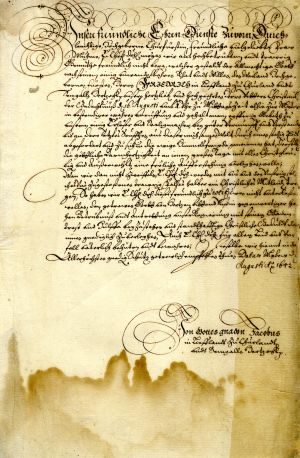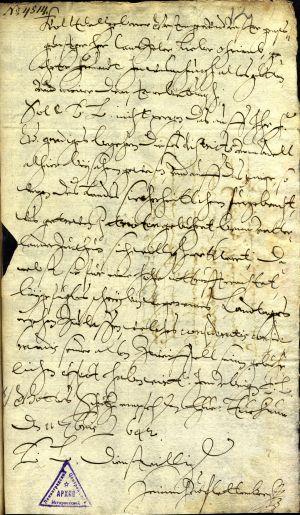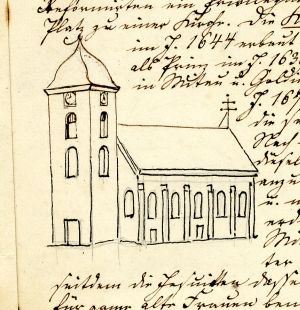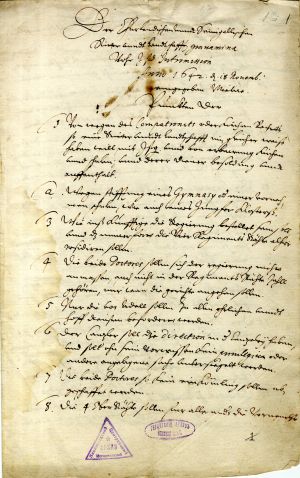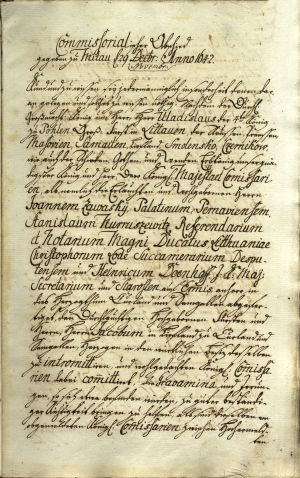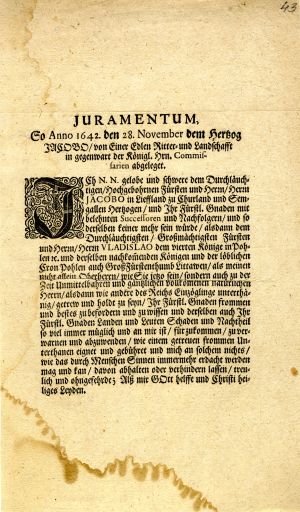Duke Frederick of Courland passed away on 16 August 1642. In the last days of his life, he handed over the reins of power completely to his nephew James. However, in order to obtain full powers as ruler, James had to ask for approval from the sovereign of Poland-Lithuania, as stipulated in the investiture ordinance of 1639, and to begin work on the promised Catholic church in Mitau/Jelgava (building work on a Catholic church in Goldingen/Kuldīga having commenced already in June 1641). Even though Frederick’s death was not sudden, it did cause some insecurity in the duchy, because, pending approval of James’s accession by Poland-Lithuania, real power was in the hands of the councillors forming the duke’s government. Meanwhile, James left Mitau/Jelgava in late August and resided on estates in Semigallia/Zemgale. The situation was further complicated by the fact that the Diet (Landtag), had not assembled since 1638, even though the duchy’s nobility had requested that it be convened. Because of this, the senior councillors and James himself were worried that unrest might break out, or that there might be an invasion from outside. In order to reassure the population, along with the announcement of Frederick’s death, the promise to safeguard the duchy made in 1639 by Władysław IV, King of Poland, was read out from church pulpits, local political meetings of the nobles were held, and the castle garrisons and foresters were commanded to stand ready to repel a possible attack.
Even though Duke James initially refused to convene the diet before the inhabitants of the duchy had sworn an oath of loyalty to him, nevertheless, under pressure from the nobility and from a commission sent by the King of Poland, he acceded to the demand. In November, in the space of a few days, representatives of the nobility drew up a list of complaints, which they submitted to James, leading to heated debate between the duke’s representatives and the nobles. Finally, with the mediation of the Polish commissars, a settlement was reached, the so-called Decision of the Commission or Act of Composition, signed by James and by the deputies of the nobles on 29 November 1642. That same day, in a solemn ceremony in Mitau/Jelgava Castle, the king’s commissars placed the duchy under James’s rule, and he himself gave a written undertaking (Reversales) to respect all the privileges the nobility had enjoyed hitherto, as well as the agreement that had just been reached and the constitution of the duchy, or Formula regiminis, the “Formula of Rule”.
1. Announcement by James of the death of Duke Frederick. August 1642 [undated]. Draft. LVVA, collection 554, inventory 3, file 39, p. 8.
The official text, disseminated on 20 August, states that Duke Frederick had died at approximately 1 p.m. on 16 August, whereas the notes of castle court secretary Godfried Fabricius record that Frederick had actually died on 15 August, but that for political reasons it had been decided not to announce the old duke’s demise immediately. James had signed an instruction for the envoy to the King of Poland, who was to ask for him to be confirmed in power as Duke James, already on 14 August, when Frederick was still alive.
2. Letter from Heinrich von Plettenberg, Supreme Captain (Oberhauptmann) of Tuckum/Tukums District, to nobleman Christoph Fircks. Tuckum/Tukums, 11 September 1642. LVVA, collection 554, inventory 1, file 254, p. 12.
Plettenberg reports that, in accordance with the duke’s instruction, he has held a meeting of the nobility of the area, in the course of which they have all displayed great patriotism and affirmed their wish to safeguard the Fatherland. Also, a request was expressed at the meeting that the diet of the duchy be convened as soon as possible.
3. Declaration by Władysław IV, King of Poland, to the Supreme Ducal Councillors (Oberräte). Nowe Miasto, 8 October 1642. LVVA, collection 554, inventory 1, file 254, p. 50.
The king announces that, in order to take care of Duke James’s investiture and resolve various issues, he is sending to Courland a special commission including Jan Zawadzki, Voivode of Pernau/Pärnu, Stanisław Naruszewicz, Notary of the Grand Duchy of Lithuania, Christoph Lode, judge of the Province of Dorpat/Tartu, and Heinrich Dönhof, Secretary to the King. The commissars arrived in Mitau/Jelgava on 10 November, and remained there until early December. In accordance with an instruction from James, they were accommodated not in the palace but in the town, each commissar living with a different citizen.
4. Excerpt from a description of the events of 1642 by Godfried (Gottfried) Fabricius, Secretary of Mitau/Jelgava Castle Court. LVVA, collection 554, inventory 3, file 436, p. 10.
One of the conditions for James to gain the throne of the duchy was that a Catholic church had to be built in Mitau/Jelgava in accordance with an undertaking given in 1639. Jerzy or Georg Tyszkiewicz, Bishop of Samogitia, arrived on 23 October to resolve this question. The next day, James showed the bishop the site chosen for the church, an empty plot belonging to the deceased Mitau/Jelgava citizen Tilmann Marschall, and a second plot next to Sünder Straße (later Annas iela; nowadays Raiņa iela), with the promise that building work would commence the following spring.
5. Mitau/Jelgava Catholic Church. Drawings by Julius Döring. Mid-19th century. LVVA, collection 5759, inventory 2, file 1107, p. 124.
The date of construction of the Church of St. George has so far not been established, but in a letter on 25 January 1645 to Duchess Elisabeth Magdalena, the town council of Mitau/Jelgava mentions that work on the Catholic church has already commenced and that the duke must continue the work, so as to avoid incurring the displeasure of the Polish crown. Accordingly, the date of completion of the church given by Döring, 1644, is wrong. Alike erroneous is the information to be found on the internet that Duke Frederick had built a Catholic church in the 1630s.
The duke was responsible for maintaining the Catholic church in Mitau/Jelgava and providing for the clergymen. He decided that the Catholic priest should be paid from his estate of Bergfriede/Svirlauka. In religious terms, the church was subordinate to the Bishop of Samogitia.
6. Initial page of a list of complaints (Gravamina) submitted to the duke by the nobles. Mitau/Jelgava, 18 November 1642. Transcript. LVVA, collection 554, inventory 1, file 1629, p. 1.
After the solemn reception for the Polish commission in Mitau/Jelgava Castle on 12 November by the government of the duchy and Frederick’s widow Elisabeth Magdalena, talks began between the government councillors, on the one hand, and the nobles of Courland, on the other. The latter demanded that the list of complaints they had submitted should be reviewed prior to James’s investiture. This consisted of 59 articles, covering a wide range of issues relating to state administration, the church, courts and the economy, and was mainly directed towards preserving the privileged status of the nobility. The town citizens also addressed the government with their complaints, but due to the pressure exerted by the nobles, review of the complaints from the town citizens was put off until a later time. Simultaneously, talks were held between representatives of the duke and the Polish commissars.
7. Initial page of the Agreement of the Commission or Act of Composition (commissorialischer Vergleich, Acta Compositionis,). Mitau/Jelgava, 29 November 1642. Transcript. LVVA, collection 554, inventory 1, file 1589, p. 136.
Since the duke’s councillors and the representatives of the nobles could not agree on a large number of the submitted articles, the final decision was left to the king’s commission, as reflected in the title of the document. The original is not preserved, and the number of articles listed in the surviving transcripts varies. Most of them list 50 articles which include a series of regulations pertaining to the system of state administration, for example that henceforth only Mitau/Jelgava should be regarded as the duke’s main residence and the capital city of the Duchy. This meant that Goldingen/Kuldīga lost its status as the second capital of the duchy. In addition, the agreement reaffirmed that the economy (Oeconomica) remained solely the duke’s responsibility, which meant he took on the burden of maintaining the duchy’s administrative apparatus.
8. Form for the citizen’s oath of allegiance. Mitau/Jelgava, 28 November 1642. LVVA, collection 554, inventory 3, file 27, p. 43.
Although the date of the oath is given as 28 November, in reality it was given the next day, when the investiture of Duke James was held at Mitau/Jelgava Castle. The participants also included the nobles who had arrived to take part in the diet, representatives of the towns, courtiers and officials. After Jan Zawadzki, head of the Polish commission, had called upon the people of the duchy to love and respect James, the duke’s senior secretary Barthold Meyer, called Rautenfels (Meyer, genannt Rautenfels) read the text of the oath of allegiance, which was then given by all those assembled. The other nobles of the duchy gave their oaths in their nearest castle in January 1643.
9. Instruction from the duke to Hermann Dönhof, Supreme Captain of Mitau/Jelgava District. Mitau/Jelgava, 5 December 1642. The text of the oath to be given as well as an excerpt from the list of residents of Mitau/Jelgava who had given the oath on 13 December 1643. Copies. LVVA, collection 554, inventory 3, file 27, pp. 53–54.
In early December, James ordered that the residents of towns and villages, including Mitau/Jelgava, should give their oath of allegicance. The ceremony was held on 13 December in Mitau/Jelgava town hall in the presence of supreme captain Dönhof and Mitau/Jelgava castle court secretary G. Fabricius. The first to give the oath were two town councillors who had not been present in the castle on 29 November, then came the town aldermen and elders, followed by the town citizens, grouped according to the town quarters. There was a separate oath-giving ceremony for the clergy and schoolmasters, and the merchants’ journeymen and widows.
